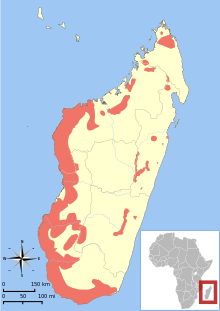Mouse lemur
| Mouse lemurs | |
|---|---|
 |
|
| Pygmy mouse lemur (M. myoxinus) | |
| Scientific classification | |
| Kingdom: | Animalia |
| Phylum: | Chordata |
| Clade: | Synapsida |
| Class: | Mammalia |
| Order: | Primates |
| Suborder: | Strepsirrhini |
| Family: | Cheirogaleidae |
| Genus: |
Microcebus É. Geoffroy, 1834 |
| Diversity | |
| About 24 species | |
 |
|
| Combined distribution of Microcebus | |
| Synonyms | |
|
|
The mouse lemurs are nocturnal lemurs of the genus Microcebus. Like all lemurs, mouse lemurs are native to Madagascar.
Mouse lemurs have a combined head, body and tail length of less than 27 centimetres (11 in), making them the smallest primates (the smallest species being Madame Berthe's mouse lemur); however, their weight fluctuates in response to daylight duration. Lemurs and Mouse Lemurs were announced by the IUCN as the most endangered of all vertebrates. There are about 24 mouse lemur species identified by 2016. There were only 2 known mouse lemur species by 1992. It was estimated that the 24 mouse lemur species evolved from a common ancestor 10 million years ago. Evolution of mouse lemurs is an example for adaptive radiation.
Mouse lemurs are omnivorous; their diets are diverse and include insect secretions, arthropods, small vertebrates, gum, fruit, flowers, nectar, and also leaves and buds depending on the season.
Mouse lemurs are considered cryptic species - with very little morphological differences between the various species, but with high genetic diversity. Recent evidence points to differences in their mating calls, which is very diverse. Since mouse lemurs are nocturnal, they might not have evolved to look differently, but had evolved various auditory and vocal systems.
Mouse lemurs have the smallest known brain of any primate, at just 0.004 pounds (2 grams).
Mouse lemurs are also known for their sperm competition. During breeding seasons, the testicles of male mouse lemurs increase in size to about 130% of their normal size. This was speculated to increase the sperm production thereby conferring an advantage for the individual to bear more offspring. There are various hypotheses relating the rapid evolution of mouse lemur species to this sperm competition.
...
Wikipedia
